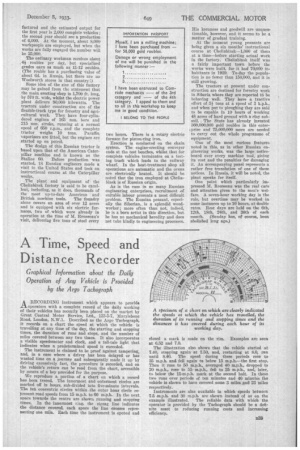A Time, Speed and Distance Recorder
Page 53

If you've noticed an error in this article please click here to report it so we can fix it.
Graphical Information about the Daily Operation of Any Vehicle is Provided by the Argo Tachograph
A RECORDING instrument which appears to provide .tioperators with a complete record of the daily working of their vehicles has recently been placed on the market by Great Central Motor Service, Ltd., 133-5-7, Marylebone Road, London, N.W.1. Described as the Argo Tachograph, it records on a chart the speed at which the vehicle is travelling at any time of the day, the starting and stopping times, the duration of runs and steps, and the number of miles covered between any two times. It also incorporates a visible speedometer and clock, and a tell-tale light that indicates when a predetermined speed is exceeded.
The instrument is claimed to he proof against tampering, and, in a ease where a driver has been delayed or has wasted time on a journey and subsequently made it up by driving excessively fast, the procedure is recorded, and on the vehicle's return can be read from the chart, accessible by means of a key provided for the purpose.
We reproduce a portion of a chart on which a record has been traced. The innermost and outermost circles are marked off in hours, sub-divided into five-minute intervals. The ten concentric circles within the outer hour circle represent road speeds from 15 m.p.h. to 60 m.p.h. In the next space towards the centre are showu running and stopping times. In the innermost Eng, the zigzag line indicates the distance covered, each space the line crosses representing one mile. Each time the instrument is opened and dosed a mark is made on the rim. Examples are seen at 6.52 and 7.0.
The illustration also shows that the vehicle started at 7.40, stopping again at 7.50, and, restarting at 8.0, ran until 8.40. The speed during these periods rose to 35 m.p.h. and fell again to below 15 m.p.h.—the first atop. Then it rose to 50 m.p.h., averaged 40 m.p.h., dropped to 20 m.p.h., rose to 55 m.p.h., fell to 25 m.p.h., and, later, to below the 15-m.p.in mark at the second halt. In these two runs over periods of ten minutes and 40 minutes the vehicle is shown to have covered some 3 miles and 23 miles respectively. Instruments are also available in which speeds between 7.5 m.p.h. and 30 m.p.h. are shown instead of as on the example illustrated. The reliable data with which the operator is provided by the Tachograph should be a definite asset to reducing running costs and increasing efficiency.




























































































